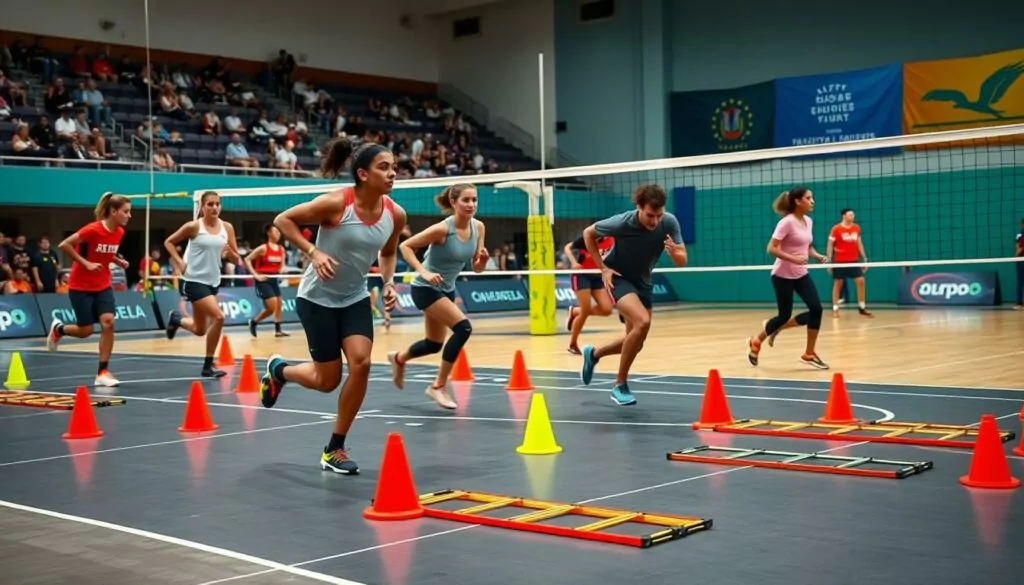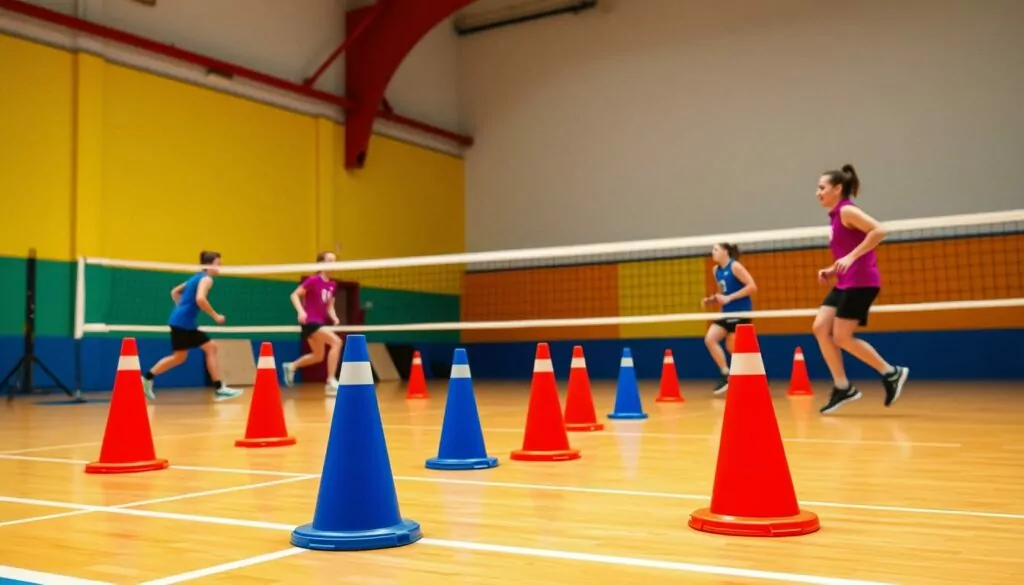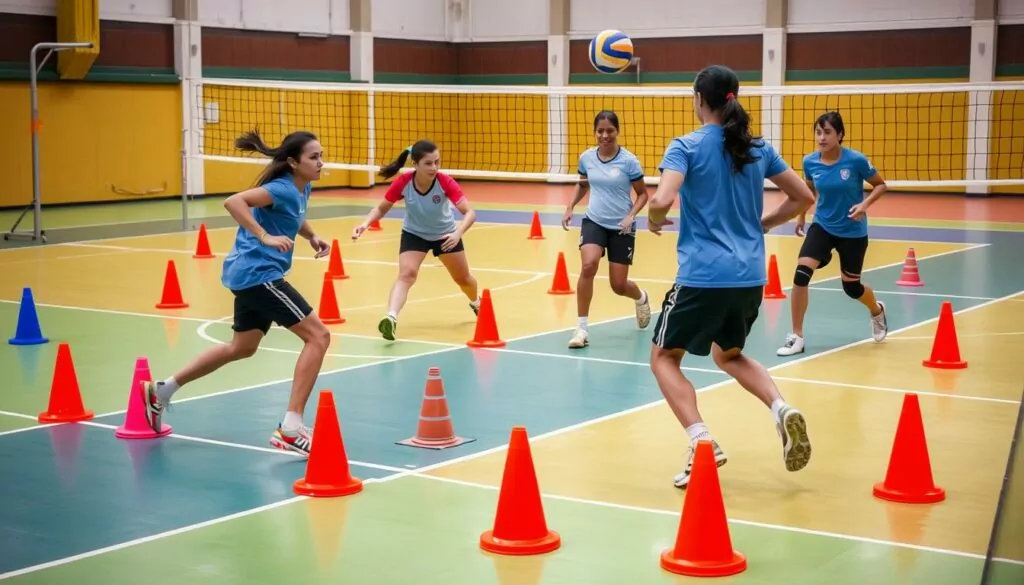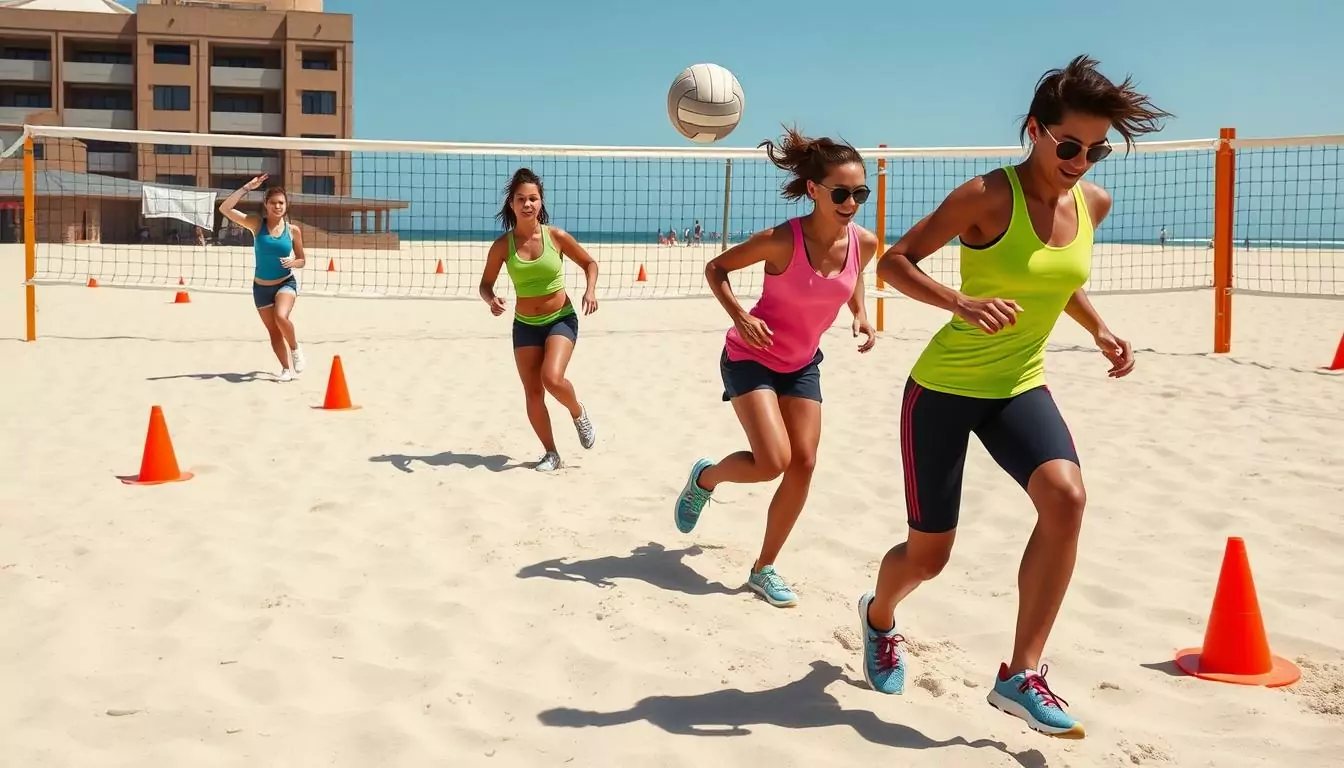I’ll never forget the day I watched my high school volleyball team transform from sluggish to spectacular. Our coach introduced a series of volleyball agility drills that seemed simple at first, but boy, did they pack a punch! Within weeks, our players were diving for balls they’d never have reached before, and our defense became nearly impenetrable. It was like watching a group of cats suddenly develop superhuman reflexes.
This experience showed me firsthand the power of speed and quickness training in volleyball. These drills weren’t just about moving faster; they were about rewiring our brains and bodies to react instinctively on the court. As I watched my teammates leap, pivot, and sprint with newfound grace, I realized we weren’t just playing volleyball anymore – we were dancing with the game itself.
Now, as I share these insights with you, I’m excited to dive into the world of volleyball agility drills that can elevate your game. Whether you’re a beginner looking to build a solid foundation or an experienced player aiming to sharpen your skills, these exercises will challenge you to push your limits and unlock your full potential on the court.
Key Takeaways
- Volleyball agility drills significantly improve court performance
- Speed and quickness training enhances reaction time and court coverage
- Agility exercises rewire the brain for better instinctive responses
- Proper agility training can benefit players at all skill levels
- Consistent practice of agility drills leads to noticeable performance improvements
Understanding the Importance of Agility in Volleyball

Agility plays a crucial role in volleyball success. As a player, I’ve seen firsthand how quick movements and fast reactions can make or break a game. Let’s dive into why agility is so vital and how it impacts performance on the court.
How Agility Affects Court Performance
Agility is the backbone of effective court coverage drills. It allows players to swiftly change direction, reach for difficult balls, and maintain balance during intense rallies. I’ve noticed that agile players often dominate the game, covering more ground and making seemingly impossible plays.
The Science Behind Quick Movements
Quick movements in volleyball rely on muscle fiber activation and neuromuscular coordination. Our bodies use fast-twitch muscle fibers for explosive actions. Regular practice of reaction drills enhances the efficiency of these fibers, leading to faster and more precise movements on the court.
Benefits of Improved Reaction Time
Enhanced reaction time is a game-changer in volleyball. It allows players to:
- Respond faster to opponent’s attacks
- Adjust to unexpected ball trajectories
- Execute complex plays with precision
- Reduce injury risk through better body control
Through consistent practice of reaction drills, I’ve seen dramatic improvements in my own gameplay and that of my teammates.
| Agility Component | Impact on Performance | Training Method |
|---|---|---|
| Quick Movements | Improved court coverage | Ladder drills |
| Fast Reactions | Better ball control | Visual cue exercises |
| Directional Changes | Enhanced defensive positioning | Cone drills |
Volleyball Agility Drills for Beginners

I’m excited to share some simple yet effective volleyball agility drills perfect for beginners. These exercises will help you build a strong foundation in footwork and lateral movement, setting you up for success on the court.
Let’s start with basic footwork exercises. The high-knee drill is a great way to improve your quick steps and coordination. Stand in place and lift your knees high, alternating legs rapidly. Aim for 30 seconds at first, gradually increasing your time as you build stamina.
Next, try the shuffle drill to enhance your lateral movement. Mark two points about 10 feet apart. Shuffle sideways from one point to the other, keeping your body low and your feet moving quickly. This drill mimics the side-to-side movements often required in volleyball.
For a more dynamic exercise, practice the zig-zag run. Set up four cones in a zigzag pattern. Sprint from cone to cone, focusing on sharp turns and quick acceleration. This drill improves your agility and ability to change direction rapidly.
| Drill | Duration | Focus Area |
|---|---|---|
| High-Knee | 30 seconds | Quick steps, coordination |
| Shuffle | 1 minute (30 seconds each direction) | Lateral movement |
| Zig-Zag Run | 5 repetitions | Agility, direction change |
Remember, consistency is key. Practice these drills regularly, and you’ll soon notice improvements in your agility and court movement. As you progress, you can increase the intensity and complexity of these exercises to continue challenging yourself.
Mastering Footwork with Agility Ladder Exercises
I’ve found that agility ladder workouts are game-changers for volleyball players. These footwork exercises sharpen your speed and precision on the court. Let’s dive into some effective drills that’ll take your game to the next level.
Basic Ladder Patterns
Start with simple patterns to build a solid foundation. The high knees drill is perfect for beginners. Step into each square, lifting your knees high. This improves your foot speed and coordination. Another basic drill is the lateral shuffle, moving side-to-side through the ladder. It’s great for developing quick lateral movements essential in volleyball.
Advanced Footwork Combinations
Once you’ve mastered the basics, try more complex patterns. The Icky Shuffle is a favorite among athletes. It involves quick in-and-out steps, challenging your agility and balance. For a real test, try the Crossover drill. It requires you to cross one foot over the other as you move through the ladder, enhancing your ability to change direction swiftly.
Incorporating Ball Control
To make these drills volleyball-specific, add a ball into the mix. Try bouncing a volleyball while performing ladder drills. This multitasking exercise improves your hand-eye coordination and ball control. You can also practice setting or bumping the ball to a partner after completing each ladder run. These combined agility ladder workouts and ball handling exercises will significantly boost your on-court performance.
Cone Drills for Enhanced Court Coverage

Cone drills are a game-changer for volleyball players looking to boost their court coverage skills. I’ve found these exercises incredibly effective in improving spatial awareness and defensive positioning. Let’s dive into some of my favorite cone drills that’ll take your game to the next level.
One of the most popular court coverage drills is the “W” drill. Set up five cones in a W shape on the court. Start at the middle cone and sprint to each outer cone, touching it before returning to the center. This drill simulates quick movements across different areas of the court, enhancing your ability to reach balls in various positions.
Another effective exercise is the “Box” drill. Place four cones in a square formation, about 10 feet apart. Move around the cones in different patterns – forward, backward, and side-to-side. This drill improves your footwork and helps you cover more ground efficiently during matches.
For a more advanced court coverage drill, try the “Star” pattern. Set up five cones in a star shape and move between them in various sequences. This challenges your agility and decision-making skills, crucial for reacting to unpredictable plays during a game.
“Cone drills have revolutionized my approach to court coverage. They’ve made me quicker, more agile, and better prepared for any situation on the court.”
Remember, consistency is key when practicing these cone drills. Incorporate them into your regular training routine, and you’ll see significant improvements in your court coverage and overall performance.
Plyometric Training for Explosive Movement
Plyometric drills are a game-changer for volleyball players seeking explosive power. I’ve seen firsthand how these exercises can transform an athlete’s performance on the court. Let’s dive into some effective jump training techniques that’ll take your game to new heights.
Box Jump Variations
Box jumps are a staple in plyometric training. Start with a low box and progress to higher ones as you build strength. I recommend mixing in single-leg box jumps to challenge your balance and mimic the unilateral movements common in volleyball.
Lateral Bound Exercises
Lateral bounds are crucial for developing side-to-side agility. Practice by jumping from one leg to the other, covering distance horizontally. This exercise mimics the quick lateral movements needed for blocking and digging.
Multi-Directional Jump Training
Incorporating multi-directional jumps in your routine is key. Set up a square with cones and practice jumping diagonally, forward, backward, and side-to-side. This drill enhances your ability to change direction rapidly during intense rallies.
| Plyometric Exercise | Sets | Reps | Rest (seconds) |
|---|---|---|---|
| Box Jumps | 3 | 8-10 | 60 |
| Lateral Bounds | 3 | 12-15 (each side) | 45 |
| Multi-Directional Jumps | 4 | 20 (5 each direction) | 90 |
Remember, proper form is crucial in plyometric training. Start with lower intensity and gradually increase as you master each movement. These drills will significantly boost your explosive power, making you a more formidable player on the volleyball court.
Advanced Speed and Reaction Training Methods
I’ve found that taking your volleyball game to the next level requires mastering advanced speed and quickness training techniques. These methods push your limits and sharpen your reflexes on the court.
Partner-Based Reaction Drills
Working with a partner can supercharge your reaction drills. Try the mirror drill: face your partner and mimic their movements as they quickly change directions. This improves your ability to read and react to opponents’ movements during a match.
Visual Cue Response Exercises
Visual cues are crucial in volleyball. Practice responding to hand signals or colored cards held up by a coach or teammate. Start in a ready position and sprint to different court areas based on the cue. This drill enhances your visual processing and decision-making speed.
Complex Movement Patterns
Incorporate multi-directional movements into your speed and quickness training. Set up a course with cones that requires you to sprint, backpedal, shuffle, and dive. Time yourself and aim to improve your speed while maintaining proper form. These drills simulate the unpredictable nature of volleyball rallies.
Remember, consistency is key when practicing these advanced methods. Integrate them into your regular training routine to see significant improvements in your on-court agility and reaction time.
Conclusion
I’ve shared a variety of volleyball agility drills designed to boost your performance on the court. From basic footwork exercises to advanced plyometric training, these drills cover all aspects of agility needed in volleyball. By incorporating these exercises into your regular training routine, you’ll see noticeable improvements in your speed, reaction time, and overall court coverage.
Remember, consistent practice is key to mastering these volleyball agility drills. Start with the beginner-level exercises and gradually progress to more complex movements as your skills improve. This step-by-step approach will help you build a solid foundation and prevent injuries while enhancing your agility.
As you continue to work on these drills, you’ll find yourself moving more efficiently and reacting faster during matches. Your improved agility will give you an edge over your opponents, allowing you to reach difficult balls and make those game-changing plays. So, get out there and start incorporating these drills into your training – your future volleyball performance will thank you!
